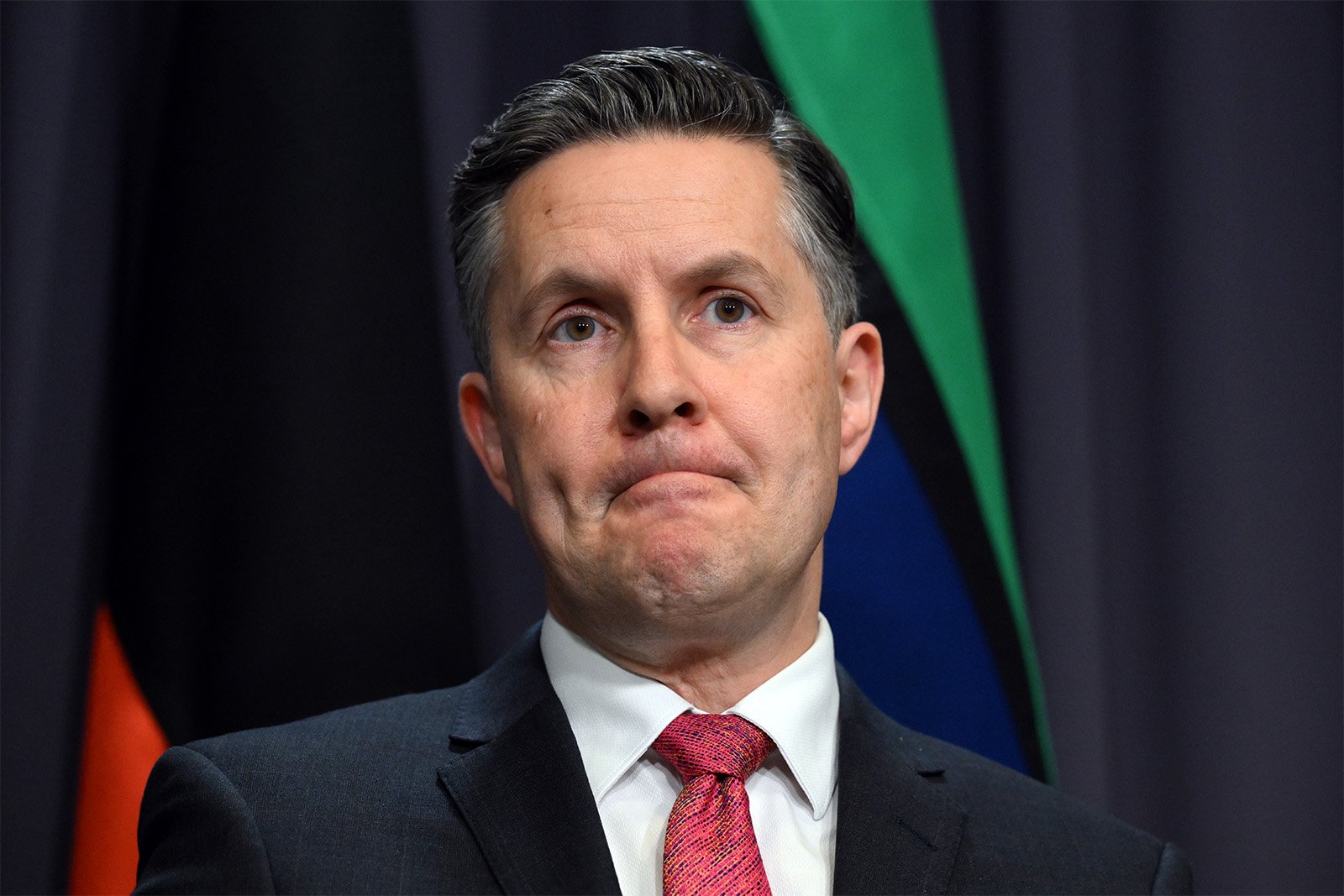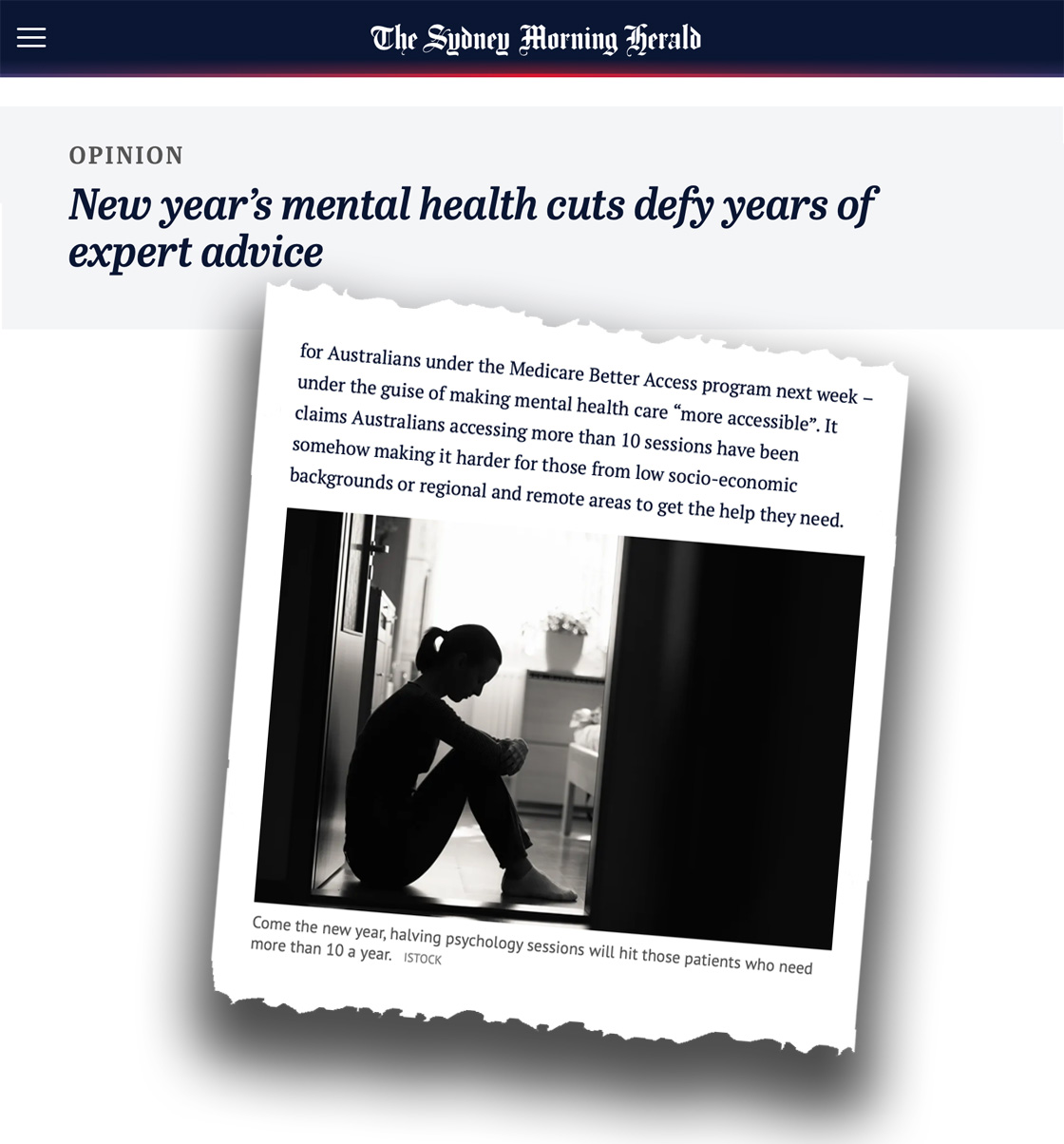Amanda Tattersall
Our mental health debate needs a proper dose of crazy to get it on the right track

At the end of last year, as our weary ‘living with Covid’ bodies honoured the silly season with a little more day drinking and a little less doom scrolling, Federal Health Minister Mark Butler confirmed that the government had no plans to save the Morrison government’s Covid-era bonus funding for mental health care.
The number of Medicare-funded trips to see a psychologist would return to 10 per year, Butler confessed, down from 20 under Morrison.
To say that many in the mental health space were surprised, is an understatement. The mental health plans had been extremely popular during Australia’s rolling covid lockdowns, when day drinking and doom scrolling proxied as diagnostic criteria for our exploding mental health crisis. For many the psychology sessions were a safety net, and at the height of the crisis it was speculated that this alongside other interventions had contributed to a reduction in the rate of suicide.
But Butler went on the front foot about his decision. He claimed on ABC radio that the extra funding had actually reduced access to mental health care for new patients, by clogging up the system with people who already had access to it. The number of psychologists is finite, and by doubling the number of sessions each person could get, the Government’s modelling suggested that the number of people accessing psychologists had dropped by 7%.
Pretty counter-intuitive, huh?
Of course, many medical practitioners were appalled by the decision, while others sided with the government, and a fierce debate raged for days.
On one side were psychiatric researchers – Ian Hickie, Pat McGorry, Jane Halton, Sam Harvey. They backed the government’s decision, agreeing that the axed subsidy wasn’t targeting those most in need, and called for a more focused approach to mental illness funding. On the other side, predominantly psychologists criticised the decision, arguing that it would cause harm to end a subsidy before a solution was developed, noting that it would have a particularly harsh effect on young people.
But how real was this so-called debate?
Far from a sign that we’re ready for a post-pandemic reckoning about our mental health crisis – this was a trifling brouhaha between medical professionals about how best to provide medical services. Some wanted “better evidenced based mental healthcare reform” (Hickie), others sought “specialised treatment programs for people with complex needs” (McGorry), alternatively people called for the maintenance of the 20 subsidised sessions (Harrigton), for doubling the sessions to 40 (Carr-Gregg) or for strategies to deal with healthcare workforce shortages.
Labelling this episode a debate had an unseen side effect – it helped us avoid having any actual debate about the biggest assumption guiding our approach to mental health – which is that the medical system is the answer to the mental illness crisis.
In late January, Mark Butler is holding a mental health roundtable with these medical professionals to hammer out some longer-term solutions. But as someone who’s been buffeted in and around the mental health system for decades, I’m not holding my breath. My fear is that the roundtable could end up another case of “if the only tool you have is a hammer, everything looks like a nail?” If you only take medical professionals into the brainstorm, then all you’ll come out with are more medical solutions.
You see, I’ve lived with bipolar disorder for 25 years and spent plenty of time on the other side of the doctors table, asking for help to manage my pattern of eye-watering highs and catatonic lows. I’ve given it my all; therapists and medication, psychiatrists and psychologists, as well as alternative care like acupuncture, exercise, mindfulness and too many self-help books. Living with mental illness involves spending a lot of time asking people for advice.
In some ways it was no surprise that they didn’t ask a bunch of crazy people like me to the come to the mental illness roundtable. We’re seen as the ones needing solutions, not providing them. But it was Albert Einstein who said that doing the same thing over and over again and expecting different results is the definition of insanity. So perhaps, by not asking for representation from us, they’re the insane ones?
I reckon the mental illness debate needs a good dose of wisdom from those of us who know all about insanity.

In our popular imagination, mental illness looks like someone lying on a therapy couch, or, as the Fairfax papers dolled up in December, a black and white lonely woman crest-fallen in front of a door yearning for meaning. Thankfully, real life with a mental illness is vastly more complex and interesting. When I complained to my husband about Fairfax’s choice of picture, insisting “that’s not what I look like,” he jibed “a better photo would be of you spending lots of money.” Ouch. But let me run with his slight to make a bigger point. This (embarrassing) depiction of hypomanic me spending with free-wheeling abandon is just one of a kaleidoscope of images rendered invisible in popular discussion about mental illness.
My bipolar is alive; it moves based on what I encounter. For many years in my work as a professional social change maker, I naively thought that my brain could somehow be secret and separate from my job. But even in the worthy, values-driven not-for-profit world, I had a lot of problems. It wasn’t just the shame that I felt from having a psychosis at 19 (which reached its nadir at a very public 600 person student conference), but I was called crazy (and much worse) to my face and behind my back in the years that followed. I tried to keep my bipolar private, but it was always there. As I helped set up new organisations like GetUp and Sydney Alliance I was grateful for the energy and creativity that congealed when my mind elevated, and for a time I found ways to dance, taking breaks or shifting gears, as pathways through depression.
But as I grew older, my bespoke roller-coaster required greater intervention and not long after the birth of my second son I engaged a team medical professionals. Over time I became brave enough to talk about my mental health with workmates. By then I was the CEO of a complex organisation – small enough to live in perpetual financial stress yet big enough to be riddled with stakeholder conflict. It was hard. I tried for 9 years. But it broke me – I had another psychosis at age 38. Then at the meeting that was scheduled to plan my return to work, I lost my job.
Until that point, I had uncritically accepted the idea that mental illness was a medical issue and therefore my responsibility. When I was still in the psychiatric ward at age 19, a doctor explained my bipolar to me like this: “I had a chemical imbalance in my brain, which was an illness that could be managed with medication – lithium.” You’re probably familiar with the medical story and its key message – that mental illness is all about you – about how you are broken, but how you can be treated. I found relief in this narrative when crisis struck again over the years – it offered a plan of action in the face of despair. I’ll always be grateful for medical expertise; I wouldn’t be here without it.
But my second psychosis unsettled things, partly because the logic of the medical story was such a devastating tale to bear. Its argument that we are personally responsible for our mental health left me with only one conclusion – that I was a failure. While a depressive muscle memory held that bleakness for a time, support from family, doctors, friends and a new job slowly gave me space to see things differently.
Just because healthcare helps, doesn’t mean that a medical lens has all the answers when It comes to mental illness.For years before my psychosis my weekly therapy sessions had focused on my very real anxiety about managing my increasingly overwhelming workplace. My doctor coached me, medicated me, helped me plot out strategies and find support, and a couple of times wrote out a medical certificate when I was breaking. But at the end of every 50 min session, he sent me back out into that world. A world of work that was making me sick.
When we see mental illness as personal, we focus on the consequences of mental illness on the individual. We panic at the magnitude of our arresting mental illness crisis which is affecting 25% more people since 2020, and we feel it personalised in the lives of our family and friends. Is it any wonder that we call for more psychological and psychiatric support and Medicare subsidies? In this context it makes sense that the voice of medical care has become so dominant.
But mental illness isn’t just about crisis. It’s about life, like my life. If you see me through a medical lens you are drawn to my weaknesses. Twenty five years of bipolar; psychosis, ongoing treatment, permanently medicated – a weakened individual in need of care.
But through my eyes – mental illness looks different. Medical support matters and I work every day to stay healthy, but it is only part of the story. My ability to thrive or struggle is profoundly shaped by the world beyond the doctor-patient relationship. My workplace and the stresses and pressures it produces, my school and its competitive or caring culture, my accepting or judgmental community organisation or case worker – these all affect my mental illness. Then above any single institution, metaphysical social forces like climate change, Covid or housing stress also take their toll. Living with mental illness is not just personal – it has public dimensions.
The public dimensions of mental illness are the elephant in the room of our current mental health debate. As important as it is for us to have better access to emergency mental health care, there is something fundamentally futile in mental health policy that only focuses on making more crisis services available while doing nothing about the toxic cultures in our workplaces and schools that are pushing people to seek those services in the first place.
Calling out the public dimensions of mental illness upends who we hold responsible for mental illness. Instead of mental illness being your personal responsibility, it becomes our collective public responsibility. Rather than dumping the mental health crisis on medical experts who are so overwhelmed by the lack of medical resources that they need to rationalise crumbs like Medicare subsidies, seeing the public dimensions of mental illness tries to take the solution upstream and turn off some of the triggers that are making this crisis worse.
Mental health policy needs to walk and chew gum at the same time. While we work to improve the medical services we have, we need to start a much bigger conversation that takes aim at the workplaces, schools and other public institutions that are contributing to our collective mental illness crisis.
This of course begs the question – how the hell do we do that? It is going to require us to start new conversations everywhere about mental illness. Take work – instead of employers and industry thinking that cutting edge mental health policy lies in mental illness crisis training (where staff are trained to compassionately deal with individual instances of mental illness crisis in the workplace) workplace leaders could begin a conversation amongst their workforce about how they can work together to improve the culture of their workplace so instead of triggering mental illness it supports our mental health. And this is where a public dimensions approach to mental illness becomes truly revolutionary. Because who would be better qualified to share their experience and insight about good and bad mental health culture than those who work, learn and live with a mental illness. Instead of seeing people with a mental illness as helpless – we could grow to see that people with a mental illness are the very people that everyone needs to listen to if we are to heal the toxic cultures in our public life.
What a crazy idea.






